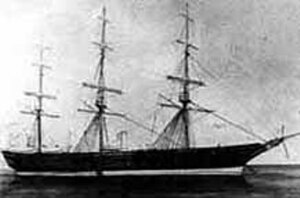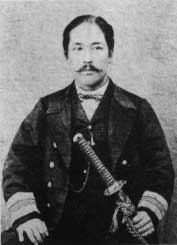Japanese frigate Kaiyō Maru

| |
| History | |
|---|---|
| Name | Kaiyomaru |
| Ordered | 1863 |
| Builder | C.Gips and Sons, Dordrecht, Netherlands |
| Laid down | August 1863 |
| Launched | 3 November 1865 |
| Commissioned | 10 September 1866 |
| Decommissioned | 1869 |
| Fate | list error: <br /> list (help) Wrecked 15 November 1868 Salvaged 1990 |
| General characteristics | |
| Displacement | 2,590 long tons (2,632 t) |
| Length | 72.2 m (236 ft 11 in) o/a |
| Beam | 13.04 m (42 ft 9 in) |
| Draught | 6.4 m (21 ft) |
| Propulsion | Coal-fired auxiliary steam engine, 400 hp |
| Sail plan | list error: <br /> list (help) Ship-rigged 3-masted sailboat Sail area 20,970 m2 (225,700 sq ft) |
| Speed | 10 knots (12 mph; 19 km/h) |
| Armament | list error: <br /> list (help) • 18 × 16 cm (6.3 in) guns • 8 × 30-pounder guns 5 more cannons later |
Kaiyō Maru (Japanese: 開陽丸) was one of Japan's first modern warships, powered by both sails and steam.
Construction

She was ordered in the Netherlands in 1863 by the Bakufu, the government of the Shogun, the Nederlandsche Handel-Maatschappij acting as agents. The ship was built at the yard of Cornelis Gips and Sons in Dordrecht, The Netherlands for the sum of 831,200 guilders[1]. At the time of launch, she was the largest wooden warship ever built by a Dutch shipyard.[2]
The construction was overseen by a Japanese military mission under Uchida Masao and Akamatsu Noriyoshi[3].
Transportation

She sailed on her maiden voyage to Japan under the command of capt. J.A.E. Dinaux, a Dutch naval officer, seconded for the mission. She arrived in Japan on 26 March 1867.
On board was Enomoto Takeaki, a Japanese Navy student who had been sent to study Naval science in the Netherlands for five years, together with fifteen other students[4]. Enomoto Takeaki was to become vice-admiral (副総裁) of the modernized Bakufu fleet upon his return to Japan, and Kaiyō Maru was to become his flagship.
Career

The Boshin War erupted soon after, near the end of 1867, in which pro-Imperial forces fought the Bakufu forces between 1867 and 1869. In September 1868, Enomoto Takeaki decided to continue combat in northern Japan together with the Daimyos faithful to the Bakufu regime, and sailed out of Shinagawa in Tokyo towards the north, with Kaiyō Maru and seven other modern ships. The ship was also carrying on board a handful of French military advisors, and their leader Jules Brunet. The rebels ended up in Hokkaidō, where they established an independent and ephemeral Ezo Republic.


Kaiyō Maru eventually became the main ship of the fleet in Hokkaidō. Many hopes were put in her to achieve naval superiority against a weaker and nascent Imperial Japanese Navy, but she eventually was wrecked in Esashi, Hokkaidō, during a storm on 15 November 1868.
Her demise is said to have demoralized Enomoto Takeaki, who had sailed in her from the other side of the world, and clearly reduced the chances of the rebel forces to succeed.
Kaiyō Maru was discovered on the seafloor in 1975, and she was salvaged and reconstructed in 1990. She is now visible at the docks in Esashi and has become a tourist attraction.
Notes
- ^ See Scheepswerf van Gips "De Merwede" Anno 1796 te Dordrecht
- ^ Bridging the Divide Leonard Blusse, p.183
- ^ Otterspeer, W. (1989) Leiden Oriental Connections, Brill, ISBN 9004090223, p. 367
- ^ Seiichi Iwao, in Biographical Dictionary of Japanese History (1978), p. 325, claims that Enomoto commanded the ship. However, in the archives of the Nederlandsche Handel-Maatschappij, nrs. 4997-5003 (now in the Dutch National Archives) the correspondence about the construction of the ship and its maiden voyage, including the contracts with capt. Dinaux and his chief engineer, first mate and ship's surgeon are kept, which contradict this [1]
References
- Bridging the Divide Léonard Blussé, 2000, Hotei Publishing ISBN 907482224X
